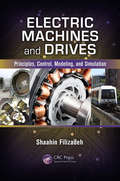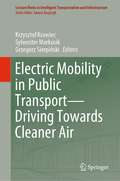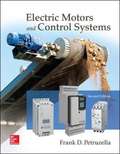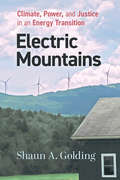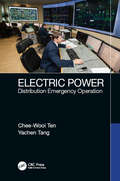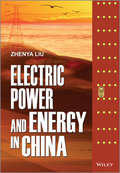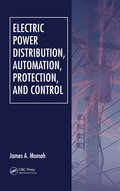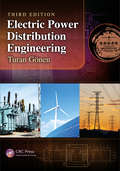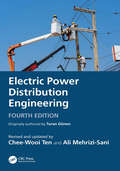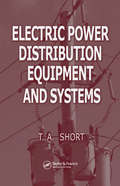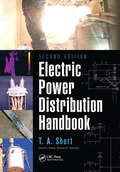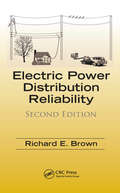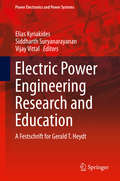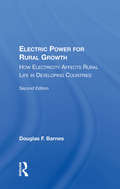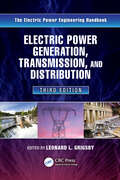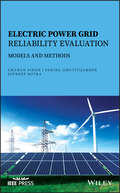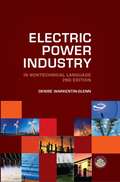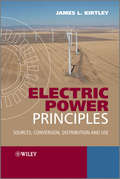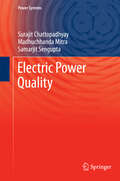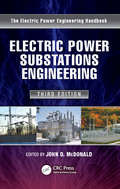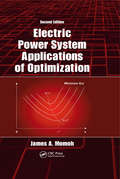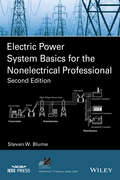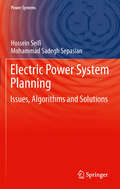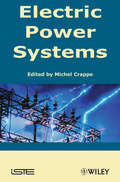- Table View
- List View
Electric Machines and Drives: Principles, Control, Modeling, and Simulation
by Shaahin FilizadehElectric machines have a ubiquitous presence in our modern daily lives, from the generators that supply electricity to motors of all sizes that power countless applications. Providing a balanced treatment of the subject, Electric Machines and Drives: Principles, Control, Modeling, and Simulation takes a ground-up approach that emphasizes fundamental principles. The author carefully deploys physical insight, mathematical rigor, and computer simulation to clearly and effectively present electric machines and drive systems. Detailing the fundamental principles that govern electric machines and drives systems, this book: Describes the laws of induction and interaction and demonstrates their fundamental roles with numerous examples Explores dc machines and their principles of operation Discusses a simple dynamic model used to develop speed and torque control strategies Presents modeling, steady state based drives, and high-performance drives for induction machines, highlighting the underlying physics of the machine Includes coverage of modeling and high performance control of permanent magnet synchronous machines Highlights the elements of power electronics used in electric drive systems Examines simulation-based optimal design and numerical simulation of dynamical systems Suitable for a one semester class at the senior undergraduate or a graduate level, the text supplies simulation cases that can be used as a base and can be supplemented through simulation assignments and small projects. It includes end-of-chapter problems designed to pick up on the points presented in chapters and develop them further or introduce additional aspects. The book provides an understanding of the fundamental laws of physics upon which electric machines operate, allowing students to master the mathematical skills that their modeling and analysis requires.
Electric Mobility in Public Transport—Driving Towards Cleaner Air (Lecture Notes in Intelligent Transportation and Infrastructure)
by Krzysztof Krawiec Sylwester Markusik Grzegorz SierpińskiThis book addresses various aspects of electric mobility deployment in public transport. These include transport policy-related issues as well as technical, organizational and technical dimensions of the fleet conversion process (from conventional one towards the increased share of electric vehicles in public transport). In the book, one may find, e.g. the determinants for the successful functioning of electrified transport systems (including charging facilities), models and methods for battery electric bus energy consumption, the analysis regarding the charging strategies (including power-grid) as well as electric vehicle battery issues. As the process of fleet conversion is multi-faceted, the book also contains the issues related to cybersecurity in public transport, autonomous vehicles and hyperloop. The book is dedicated to transport professionals, consulting companies and researchers in the field of electromobility and modern transport systems.
Electric Motors and Control Systems
by Frank D. PetruzellaThis book has been written for a course of study that will introduce the reader to a broad range of motor types and control systems. It provides an overview of electric motor operation, selection, installation, control and maintenance. Every effort has been made in this second edition to present the most up-to-date information which reflects the current needs of the industry. The broad based approach taken makes this text viable for a variety of motors and control systems courses. Content is suitable for colleges, technical institutions, vocational/technical schools as well as apprenticeship and journeymen training. Electrical apprentices and journeymen will find this book to be invaluable due to Electrical Code references applicable to the installation of new control systems and motors, as well as information on maintenance and troubleshooting techniques. Personnel involved in the motor maintenance and repair will find this book to be a useful reference text. The text is comprehensive! It includes coverage of how motors operate in conjunction with their associated control circuitry. Both older and newer motor technologies are examined. Topics covered range from motor types and controls to installing and maintaining conventional controllers, electronic motor drives and programmable logic controllers. Also Available! Activities Manual for Electric Motors and Control Systems, as well as, McGraw-Hill Education's Connect! Connect is the only integrated learning system that empowers students by continuously adapting to deliver precisely what they need, when they need it, and how they need it, so that your class time is more engaging and effective. SAVE WHEN YOU BUY A PACKAGE!Electric Motors & Control Systems 2/e Textbook + Activities Manual ISBN: 1259332837 WILL BE AVAILABLE FEBRUARY 2015
Electric Mountains: Climate, Power, and Justice in an Energy Transition (Nature, Society, and Culture)
by Shaun A. GoldingClimate change has shifted from future menace to current event. As eco-conscious electricity consumers, we want to do our part in weening from fossil fuels, but what are we actually a part of? Committed environmentalists in one of North America’s most progressive regions desperately wanted energy policies that address the climate crisis. For many of them, wind turbines on Northern New England’s iconic ridgelines symbolize the energy transition that they have long hoped to see. For others, however, ridgeline wind takes on a very different meaning. When weighing its costs and benefits locally and globally, some wind opponents now see the graceful structures as symbols of corrupted energy politics. This book derives from several years of research to make sense of how wind turbines have so starkly split a community of environmentalists, as well as several communities. In doing so, it casts a critical light on the roadmap for energy transition that Northern New England’s ridgeline wind projects demarcate. It outlines how ridgeline wind conforms to antiquated social structures propping up corporate energy interests, to the detriment of the swift de-carbonizing and equitable transformation that climate predictions warrant. It suggests, therefore, that the energy transition of which most of us are a part, is probably not the transition we would have designed ourselves, if we had been asked.
Electric Noir: Three Thrillers: The Night Market, The Poison Artist, The Dark Room
by Jonathan MooreThe &“suspense that never stops&” in this thriller trilogy set in San Francisco by the Edgar Award and Hammett Prize–nominated author (James Patterson).The Poison Artist After a fleeting encounter with a seductive woman, toxicologist Caleb Maddox becomes obsessed with finding her again. Meanwhile, he begins helping with a serial-murder investigation. Soon the search for the killer entwines with Caleb&’s hunt for the woman in &“a wicked mix of Poe, The Silence of the Lambs, and Vertigo&” (William Landay).The Dark Room Homicide inspector Gavin Cain is called in for a highly sensitive case: the mayor is being blackmailed. A series of photographs show a beautiful woman shackled to a bed. And worse revelations are to come if the mayor doesn&’t take his own life first. This &“electrifying noir thriller&” tracks Cain as he enters a web of deceit and destruction (Booklist, starred review).The Night Market In this &“sharp and scary near-future thriller,&” Inspector Ross Carver is at a crime scene where a dead man is covered in an unknown substance eating through his skin. Suddenly, he&’s hauled into a trailer and shocked unconscious. When he wakes up days later, he&’s in his own bed, lying next to his neighbor Mia—a woman he barely knows. And she knows a lot more than she&’s letting on (Publishers Weekly, starred review).
Electric Power: Distribution Emergency Operation
by Chee-Wooi Ten Yachen TangProvides the fundamentals of distribution emergency operation using graph-theoretic approach and exploration of subsystem(s) that address the operational aspects of fault occurrence to determine the possible feeder reconfiguration. Topics include: (1) Data extraction from geographic information systems (GIS), (2) Graph modeling of distribution feeders, (3) Programming for backward/forward sweeping unbalanced power flow, (4) Short circuit analysis and fault localization, (5) Fault isolation and service restoration, (6) Outage management and crew coordination, (7) Trouble call tickets and escalation to search for fault, and (8) Emerging topics of distribution management systems (DMS).
Electric Power and Energy in China
by Zhenya LiuThe acute energy problems facing China today are characterized by their own histories and realities. Some have come about because of China's energy endowment and stage of development, while others have been created by a combination of domestic and global factors. Some are the results of an accumulation of longstanding contradictions, while others are new challenges posed by the new order. There are no "miracle cures" to solve these problems instantly. What is needed is a tireless enquiry, with goals, planning and procedures, guided by a clear energy strategy. With China's increasing dependence on foreign energy sources, and the global energy situation and greenhouse gas issue exerting an increasingly prohibiting effect on China's energy development, energy diplomacy has become an important component of Chinese diplomatic affairs. Based on a "broad energy outlook", this book studies and analyzes China's energy issues and energy strategies from the perspective of electric power. Discusses a variety of issues, including energy transportation and allocation, end-user consumption, markets, early warning and emergency, technical innovation As a leading player in the power and energy area, China’s strategies attracts global attention Proposes the innovative idea of "Macro Energy Perspective" As a key player in China's energy industrial circle, the author's perspective can help global audiences to understand China's energy strategies better Electric Power and Energy in China is ideal for government energy policy makers, engineers, scientists and enterprise managers to understand China’s strategy in electric power and energy. It is also a good reference for energy economics researchers, consultants and university students.
Electric Power Distribution, Automation, Protection, and Control
by James A. Momoh<p>New methods for automation and intelligent systems applications, new trends in telecommunications, and a recent focus on renewable energy are reshaping the educational landscape of today's power engineer. Providing a modern and practical vehicle to help students navigate this dynamic terrain, Electric Power Distribution, Automation, Protection, and Control infuses new directions in computation, automation, and control into classical topics in electric power distribution. <p>Ideal for a one-semester course for senior undergraduates or first-year graduate students, this text works systematically through basic distribution principles, renewable energy sources, computational tools and techniques, reliability, maintenance, distribution automation, and telecommunications. Numerous examples, problems, and case studies offer practical insight into the concepts and help build a working knowledge of protection schemes, fault analysis and synthesis, reliability analysis, intelligent automation systems, distribution management systems, and distribution system communications. The author details different renewable energy sources and teaches students how to evaluate them in terms of size, cost, and performance. <p>Guided firmly by the author's wealth of industrial and academic experience, your students will learn the tools and techniques used to design, build, and operate future generations of distribution systems with unparalleled efficiency, robustness, and sustainability.</p>
Electric Power Distribution Engineering
by Turan Gönen<p>A quick scan of any bookstore, library, or online bookseller will produce a multitude of books covering power systems. However, few, if any, are totally devoted to power distribution engineering, and none of them are true textbooks. Filling this vacuum in the power system engineering literature, Electric Power Distribution System Engineering broke new ground. <p>Designed specifically for junior- or senior-level electrical engineering courses, the book covers all aspects of distribution engineering from basic system planning and concepts through distribution system protection and reliability. Drawing on decades of experience to provide a text that is as attractive to students as it is useful to professors and practicing engineers, the author demonstrates how to design, analyze, and perform modern distribution system engineering. He takes special care to cover industry terms and symbols, providing a glossary and clearly defining each term when it is introduced. The discussion of distribution planning and design considerations goes beyond the usual analytical and qualitative analysis to emphasize the economical explication and overall impact of the distribution design considerations discussed.</p>
Electric Power Distribution Engineering
by Chee-Wooi Ten Ali Mehrizi-SaniAre you fascinated by the complex web of electrical power that illuminates our modern world? Do you want to understand the intricate systems responsible for delivering electricity to our homes, businesses, and industries? Look no further than Electric Power Distribution System Engineering, Fourth Edition by renowned author Turan Gönen, revised and updated by Chee-Wooi Ten and Ali Mehrizi-Sani. This captivating book takes you on a journey through the fascinating realm of electric power distribution, offering a comprehensive yet accessible exploration of the engineering principles, technologies, and practices that underpin this vital aspect of our daily lives. Whether you're a curious non-specialist, an avid reader with a thirst for knowledge, or a librarian or bookseller seeking an invaluable resource, Gönen's masterwork will both enlighten and captivate you.An early leader in the academic market, this book provides an overview of classical planning for electric power distribution systems, which has been used for many years in designing and analyzing electric power distribution systems. The authors have taken a bold initiative to update the content, incorporating relevant aspects reflecting the advancements of today's evolving smart grid. Within its pages, readers will discover detailed discussions on the principles of power distribution, including the fundamentals of power generation, transmission, and distribution. The authors provide detailed explanations of the various components and equipment used in distribution systems, such as transformers, circuit breakers, switches, and protective devices. As part of the book, planning for the distribution network involves sizing and considering candidate geographical locations/regions in relation to the capacity of existing infrastructure, allowing for new additions to be built. For example, this includes locations either extending another feeder from distribution substations or building new distribution substations, depending on what makes more sense. Many assumptions have been made for non-existing distribution feeders to calculate ballpark figures for determining voltage profile and power losses if they were to be constructed. Readers will gain insights into how these considerations translate into net positive, net negative, or net-zero loads. All of these aspects can be gradually integrated with renewable energy sources, innovative grid technologies, and distribution automation over time.The authors involved in this book have made significant contributions to the state-of-the-art development by incorporating recent updates from the literature, thereby addressing the latest advancements. One remarkable feature of Turan Gönen's Electric Power Distribution System Engineering is its strong focus on practical applications and real-world scenarios. In addition to providing theoretical knowledge, the book also offers numerous examples that effectively bridge the gap between theory and practice. This unique approach enables readers to comprehend the intricacies of distribution system engineering and apply their newfound knowledge to solve complex problems in the field. By seamlessly blending theoretical foundations with practical insights, Gonen's book emerges as an indispensable resource for aspiring engineers, professionals, and researchers, as it offers a comprehensive understanding of electric power distribution systems and their practical implications.
Electric Power Distribution Equipment and Systems
by Thomas Allen ShortPower distribution and quality remain the key challenges facing the electric utilities industry. Choosing the right equipment and architecture for a given application means the difference between success and failure. Comprising chapters carefully selected from the best-selling Electric Power Distribution Handbook, Electric Power Distribution Equipment and Systems provides an economical, sharply focused reference on the technologies and infrastructures that enable reliable, efficient distribution of power, from traversing vast distances to local power delivery.The book works inward from broad coverage of overall power systems all the way down to specific equipment application. It begins by laying a foundation in the fundamentals of distribution systems, explaining configurations, substations, loads, and differences between European and US systems. It also includes a look at the development of the field as well as future problems and challenges to overcome. Building on this groundwork, the author elaborates on both overhead and underground distribution networks, including the underlying concepts and practical issues associated with each. Probing deeper into the system, individual chapters explore transformers, voltage regulation, and capacitor application in detail, from basic principles to operational considerations.With clear explanations and detailed information, Electric Power Distribution Equipment and Systems gathers critical concepts, technologies, and applications into a single source that is ideally suited for immediate implementation.
Electric Power Distribution Handbook
by Thomas Allen ShortOf the "big three" components of electrical infrastructure, distribution typically gets the least attention. In fact, a thorough, up-to-date treatment of the subject hasn’t been published in years, yet deregulation and technical changes have increased the need for better information. Filling this void, the Electric Power Distribution Handbook delivers comprehensive, cutting-edge coverage of the electrical aspects of power distribution systems. The first few chapters of this pragmatic guidebook focus on equipment-oriented information and applications such as choosing transformer connections, sizing and placing capacitors, and setting regulators. The middle portion discusses reliability and power quality, while the end tackles lightning protection, grounding, and safety. The Second Edition of this CHOICE Award winner features: 1 new chapter on overhead line performance and 14 fully revised chapters incorporating updates from several EPRI projects New sections on voltage optimization, arc flash, and contact voltage Full-color illustrations throughout, plus fresh bibliographic references, tables, graphs, methods, and statistics Updates on conductor burndown, fault location, reliability programs, tree contacts, automation, and grounding and personnel protection Access to an author-maintained support website, distributionhandbook.com, with problems sets, resources, and online apps An unparalleled source of tips and solutions for improving performance, the Electric Power Distribution Handbook, Second Edition provides power and utility engineers with the technical information and practical tools they need to understand the applied science of distribution.
Electric Power Distribution Reliability (Power Engineering (Willis))
by Richard E. BrownDue to its high impact on the cost of electricity and its direct correlation with customer satisfaction, distribution reliability continues to be one of the most important topics in the electric power industry. Continuing in the unique tradition of the bestselling first edition, Electric Power Distribution Reliability, Second Edition consolidates all pertinent topics on electric power distribution into one comprehensive volume balancing theory, practical knowledge, and real world applications. Updated and expanded with new information on benchmarking, system hardening, underground conversion, and aging infrastructure, this timely reference enables you to— · Manage aging infrastructure · Harden electric power distribution systems · Avoid common benchmarking pitfalls · Apply effective risk management The electric power industry will continue to make distribution system reliability and customer-level reliability a top priority. Presenting a wealth of useful knowledge, Electric Power Distribution Reliability, Second Edition remains the only book that is completely dedicated to this important topic.
Electric Power Engineering Research and Education
by Elias Kyriakides Siddharth Suryanarayanan Vijay VittalThis unique volume covers the most compelling areas of advance in electric power engineering, from distributed generation and dispatch to power quality improvement and energy storage. The authors particularly highlight the seminal contributions of Dr. Gerald T. Heydt in the development and teaching of these technological advances, which have impacted the power industry and academia over the last 4 decades in areas such as transmission and distribution engineering, power engineering education, and centers for power engineering research.
Electric Power For Rural Growth: How Electricity Affects Rural Life In Developing Countries
by Douglas F. BarnesThis book offers important historical information on the state of rural electrification in the 1980s. It also summarizes the development of benefit evaluation methods, along with findings from recent research on the impact of rural electrification for development.
Electric Power Generation, Transmission, and Distribution (Electric Power Engineering Series)
by Leonard L. GrigsbyFeaturing contributions from worldwide leaders in the field, the carefully crafted Electric Power Generation, Transmission, and Distribution, Third Edition (part of the five-volume set, The Electric Power Engineering Handbook) provides convenient access to detailed information on a diverse array of power engineering topics. Updates to nearly every chapter keep this book at the forefront of developments in modern power systems, reflecting international standards, practices, and technologies. Topics covered include: Electric power generation: nonconventional methods Electric power generation: conventional methods Transmission system Distribution systems Electric power utilization Power quality L.L. Grigsby, a respected and accomplished authority in power engineering, and section editors Saifur Rahman, Rama Ramakumar, George Karady, Bill Kersting, Andrew Hanson, and Mark Halpin present substantially new and revised material, giving readers up-to-date information on core areas. These include advanced energy technologies, distributed utilities, load characterization and modeling, and power quality issues such as power system harmonics, voltage sags, and power quality monitoring. With six new and 16 fully revised chapters, the book supplies a high level of detail and, more importantly, a tutorial style of writing and use of photographs and graphics to help the reader understand the material. New chapters cover: Water Transmission Line Reliability Methods High Voltage Direct Current Transmission System Advanced Technology High-Temperature Conduction Distribution Short-Circuit Protection Linear Electric Motors A volume in the Electric Power Engineering Handbook, Third Edition. Other volumes in the set: K12648 Power Systems, Third Edition (ISBN: 9781439856338) K13917 Power System Stability and Control, Third Edition (ISBN: 9781439883204) K12650 Electric Power Substations Engineering, Third Edition (ISBN: 9781439856383) K12643 Electric Power Transformer Engineering, Third Edition (ISBN: 9781439856291)
Electric Power Grid Reliability Evaluation: Models and Methods
by Chanan Singh Panida Jirutitijaroen Joydeep MitraThe groundbreaking book that details the fundamentals of reliability modeling and evaluation and introduces new and future technologies Electric Power Grid Reliability Evaluation deals with the effective evaluation of the electric power grid and explores the role that this process plays in the planning and designing of the expansion of the power grid. The book is a guide to the theoretical approaches and processes that underpin the electric power grid and reviews the most current and emerging technologies designed to ensure reliability. The authors—noted experts in the field—also present the algorithms that have been developed for analyzing the soundness of the power grid. A comprehensive resource, the book covers probability theory, stochastic processes, and a frequency-based approach in order to provide a theoretical foundation for reliability analysis. Throughout the book, the concepts presented are explained with illustrative examples that connect with power systems. The authors cover generation adequacy methods, and multi-node analysis which includes both multi-area as well as composite power system reliable evaluation. This important book: • Provides a guide to the basic methods of reliability modeling and evaluation • Contains a helpful review of the background of power system reliability evaluation • Includes information on new technology sources that have the potential to create a more reliable power grid • Addresses renewable energy sources and shows how they affect power outages and blackouts that pose new challenges to the power grid system Written for engineering students and professionals, Electric Power Grid Reliability Evaluation is an essential book that explores the processes and algorithms for creating a sound and reliable power grid.
Electric Power Industry in Nontechnical Language
by Denise Warkentin-GlennIn the second edition of this bestseller, Denise Warkentin-Glenn presents in everyday language the nuances, history, and recent developments of the electric power industry. This new version includes updated information on utilities, merchant plants, rural cooperatives, government entities and more. It also has new chapters covering the 2005 Energy Policy Act, environmental standards, and updates to industry mergers and acquisitions. This important edition gives a comprehensive look at our country's most critical economic driver. Key Features: • Impacts of new regulation • Simple and clear explanations of generation, transmission and governance • How cleaner fuels and new technology are transforming the industry • The newest environmental standards
Electric Power Principles
by James L. KirtleyThis innovative approach to the fundamentals of electric power provides the most rigorous, comprehensive and modern treatment available. To impart a thorough grounding in electric power systems, it begins with an informative discussion on per-unit normalizations, symmetrical components and iterative load flow calculations.Covering important topics within the power system, such as protection and DC transmission, this book looks at both traditional power plants and those used for extracting sustainable energy from wind and sunlight.With classroom-tested material, this book also presents:the principles of electromechanical energy conversion and magnetic circuits; synchronous machines - the most important generators of electric power; power electronics; induction and direct current electric motors. Homework problems with varying levels of difficulty are included at the end of each chapter, and an online solutions manual for tutors is available. A useful Appendix contains a review of elementary network theory.For senior undergraduate and postgraduate students studying advanced electric power systems as well as engineers re-training in this area, this textbook will be an indispensable resource. It will also benefit engineers in electronic power systems, power electronic systems, electric motors and generators, robotics and mechatronics.www.wiley.com/go/kirtley_electric
Electric Power Quality
by Surajit Chattopadhyay Madhuchhanda Mitra Samarjit SenguptaIn the present day deregulated power market electric power quality issues have become great concerns of utilities, end users and manufacturers. Worldwide researches are going on to address those issues. Electric Power Quality has evolved from the researches carried out by the authors. The key features of the book can be highlighted as follows: the contents focuses, on one hand, different power quality issues, their sources and effects and different related standards, which are required for students, researchers and practising engineers and, on the other hand, measurement techniques for different power quality parameters, the content level is designed in such a way that the concepts of different power quality issues in modern power system are built up first, followed by some existing and new measurement methods. This content should attract the students, researchers and practising engineers, the predominant features are Lucid but concise description of the subject, detailed new measurement techniques and Electric Power Quality is intended for graduate, postgraduate and researchers as well as for professionals in the related fields. At the end, a chapter has been added which deals with a concept of generation of harmonics in a power system and its components.
Electric Power Substations Engineering (Electrical Engineering Handbook)
by John D. McdonaldThe use of electric power substations in generation, transmission, and distribution remains one of the most challenging and exciting areas of electric power engineering. Recent technological developments have had a tremendous impact on all aspects of substation design and operation. With 80% of its chapters completely revised and two brand-new chapters on energy storage and Smart Grids, Electric Power Substations Engineering, Third Edition provides an extensive updated overview of substations, serving as a reference and guide for both industry and academia. Contributors have written each chapter with detailed design information for electric power engineering professionals and other engineering professionals (e.g., mechanical, civil) who want an overview or specific information on this challenging and important area. This book: Emphasizes the practical application of the technology Includes extensive use of graphics and photographs to visually convey the book’s concepts Provides applicable IEEE industry standards in each chapter Is written by industry experts who have an average of 25 to 30 years of industry experience Presents a new chapter addressing the key role of the substation in Smart Grids Editor John McDonald and this very impressive group of contributors cover all aspects of substations, from the initial concept through design, automation, and operation. The book’s chapters—which delve into physical and cyber-security, commissioning, and energy storage—are written as tutorials and provide references for further reading and study. As with the other volumes in the Electric Power Engineering Handbook series, this book supplies a high level of detail and, more importantly, a tutorial style of writing and use of photographs and graphics to help the reader understand the material. Several chapter authors are members of the IEEE Power & Energy Society (PES) Substations Committee and are the actual experts who are developing the standards that govern all aspects of substations. As a result, this book contains the most recent technological developments in industry practice and standards. Watch John D. McDonald talk about his book A volume in the Electric Power Engineering Handbook, Third Edition. Other volumes in the set: K12642 Electric Power Generation, Transmission, and Distribution, Third Edition (ISBN: 9781439856284) K12648 Power Systems, Third Edition (ISBN: 9781439856338) K13917 Power System Stability and Control, Third Edition (ISBN: 9781439883204) K12643 Electric Power Transformer Engineering, Third Edition (ISBN: 9781439856291)
Electric Power System Applications of Optimization (Second Edition)
by James A. Momoh<p>As the demand for energy continues to grow, optimization has risen to the forefront of power engineering research and development. Continuing in the bestselling tradition of the first edition, Electric Power System Applications of Optimization, Second Edition presents the theoretical background of optimization from a practical power system point of view, exploring advanced techniques, new directions, and continuous application problems. <p>The book provides both the analytical formulation of optimization and various algorithmic issues that arise in the application of various methods in power system planning and operation. The second edition adds new functions involving market programs, pricing, reliability, and advances in intelligent systems with implemented algorithms and illustrative examples. It describes recent developments in the field of Adaptive Critics Design and practical applications of approximate dynamic programming. To round out the coverage, the final chapter combines fundamental theories and theorems from functional optimization, optimal control, and dynamic programming to explain new Adaptive Dynamic Programming concepts and variants. <p>With its one-of-a-kind integration of cornerstone optimization principles with application examples, this second edition propels power engineers to new discoveries in providing optimal supplies of energy.</p>
Electric Power System Basics for the Nonelectrical Professional (2nd Edition)
by Steven W. BlumeThe second edition of Steven W. Blume's bestseller provides a comprehensive treatment of power technology for the non-electrical engineer working in the electric power industry This book aims to give non-electrical professionals a fundamental understanding of large interconnected electrical power systems, better known as the "Power Grid", with regard to terminology, electrical concepts, design considerations, construction practices, industry standards, control room operations for both normal and emergency conditions, maintenance, consumption, telecommunications and safety. The text begins with an overview of the terminology and basic electrical concepts commonly used in the industry then it examines the generation, transmission and distribution of power. Other topics discussed include energy management, conservation of electrical energy, consumption characteristics and regulatory aspects to help readers understand modern electric power systems. This second edition features: New sections on renewable energy, regulatory changes, new measures to improve system reliability, and smart technologies used in the power grid system Updated practical examples, photographs, drawing, and illustrations to help the reader gain a better understanding of the material "Optional supplementary reading" sections within most chapters to elaborate on certain concepts by providing additional detail or background Electric Power System Basics for the Nonelectrical Professional, Second Edition, gives business professionals in the industry and entry-level engineers a strong introduction to power technology in non-technical terms. Steve W. Blume is Founder of Applied Professional Training, Inc., APT Global, LLC, APT College, LLC and APT Corporate Training Services, LLC, USA. Steve is a registered professional engineer and certified NERC Reliability Coordinator with a Master's degree in Electrical Engineering specializing in power and a Bachelor's degree specializing in Telecommunications. He has more than 25 years' experience teaching electric power system basics to non-electrical professionals. Steve's engineering and operations experience includes generation, transmission, distribution, and electrical safety. He is an active senior member in IEEE and has published two books in power systems through IEEE and Wiley.
Electric Power System Planning
by Hossein Seifi Mohammad Sadegh SepasianThe present book addresses various power system planning issues for professionals as well as senior level and postgraduate students. Its emphasis is on long-term issues, although much of the ideas may be used for short and mid-term cases, with some modifications. Back-up materials are provided in twelve appendices of the book. The readers can use the numerous examples presented within the chapters and problems at the end of the chapters, to make sure that the materials are adequately followed up. Based on what Matlab provides as a powerful package for students and professional, some of the examples and the problems are solved in using M-files especially developed and attached for this purpose. This adds a unique feature to the book for in-depth understanding of the materials, sometimes, difficult to apprehend mathematically. Chapter 1 provides an introduction to Power System Planning (PSP) issues and basic principles. As most of PSP problems are modeled as optimization problems, optimization techniques are covered in some details in Chapter 2. Moreover, PSP decision makings are based on both technical and economic considerations, so economic principles are briefly reviewed in Chapter 3. As a basic requirement of PSP studies, the load has to be known. Therefore, load forecasting is presented in Chapter 4. Single bus Generation Expansion Planning (GEP) problem is described in Chapter 5. This study is performed using WASP-IV, developed by International Atomic Energy Agency. The study ignores the grid structure. A Multi-bus GEP problem is discussed in Chapter 6 in which the transmission effects are, somehow, accounted for. The results of single bus GEP is used as an input to this problem. SEP problem is fully presented in Chapter 7. Chapter 8 devotes to Network Expansion Planning (NEP) problem, in which the network is planned. The results of NEP, somehow, fixes the network structure. Some practical considerations and improvements such as multi-voltage cases are discussed in Chapter 9. As NEP study is typically based on some simplifying assumptions and Direct Current Load Flow (DCLF) analysis, detailed Reactive Power Planning (RPP) study is finally presented in Chapter 10, to guarantee acceptable ACLF performance during normal as well as contingency conditions. This, somehow, concludes the basic PSP problem. The changing environments due to power system restructuring dictate some uncertainties on PSP issues. It is shown in Chapter 11 that how these uncertainties can be accounted for. Although is intended to be a text book, PSP is a research oriented topic, too. That is why Chapter 12 is devoted to research trends in PSP. The chapters conclude with a comprehensive example in Chapter 13, showing the step-by-step solution of a practical case.
Electric Power Systems (Wiley-iste Ser.)
by Michel CrappeThe creation of a European liberalized electricity internal market and EU commitments for the reduction of greenhouse gas emissions (Kyoto Protocol) and for the use of renewable energy generation technologies induce new important constraints and problems on the electric power systems in Europe. This then creates the need for more research and development to engage with these new challenges in order to preserve the reliability of these systems. This book aims to provide advanced tools, covering major aspects, for people involved with such research and development. Split into two parts (the first covering the operation and control of electric power systems and the second the stability and defence of electric power systems), this book gathers together contributions from numerous well-known European specialists in academia and the electrical industry and will be an illuminating read for those involved in this field or who have some knowledge of the fundamental notions.
